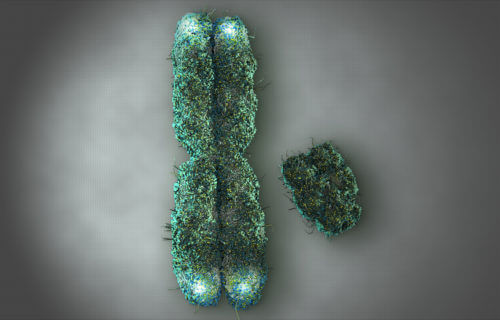By Jenny Graves, La Trobe University
The sex of human and other mammal babies is decided by a male-determining gene on the Y chromosome. But the human Y chromosome is degenerating and may disappear in a few million years, leading to our extinction unless we evolve a new sex gene.
The good news is two branches of rodents have already lost their Y chromosome and have lived to tell the tale.
A new paper in Proceedings of the National Academy of Science shows how the spiny rat has evolved a new male-determining gene.
How the Y chromosome determines human sex
In humans, as in other mammals, females have two X chromosomes and males have a single X and a puny little chromosome called Y. The names have nothing to do with their shape; the X stood for “unknown”.
The X contains about 900 genes that do all sorts of jobs unrelated to sex. But the Y contains few genes (about 55) and a lot of non-coding DNA – simple repetitive DNA that doesn’t seem to do anything.
READ: Best DNA Test Kit Services, According To Experts
But the Y chromosome packs a punch because it contains an all-important gene that kick-starts male development in the embryo. At about 12 weeks after conception, this master gene switches on others that regulate the development of a testis. The embryonic testis makes male hormones (testosterone and its derivatives), which ensures the baby develops as a boy.
This master sex gene was identified as SRY (sex region on the Y) in 1990. It works by triggering a genetic pathway starting with a gene called SOX9 which is key for male determination in all vertebrates, although it does not lie on sex chromosomes.
The disappearing Y
Most mammals have an X and Y chromosome similar to ours; an X with lots of genes, and a Y with SRY plus a few others. This system comes with problems because of the unequal dosage of X genes in males and females.
How did such a weird system evolve? The surprising finding is that Australia’s platypus has completely different sex chromosomes, more like those of birds.
In platypus, the XY pair is just an ordinary chromosome, with two equal members. This suggests the mammal X and Y were an ordinary pair of chromosomes not that long ago.
READ: Best Cologne For Men In 2023, According To Experts
In turn, this must mean the Y chromosome has lost 900–55 active genes over the 166 million years that humans and platypus have been evolving separately. That’s a loss of about five genes per million years. At this rate, the last 55 genes will be gone in 11 million years.
Our claim of the imminent demise of the human Y created a furore, and to this day there are claims and counterclaims about the expected lifetime of our Y chromosome – estimates between infinity and a few thousand years
Rodents with no Y chromosome
The good news is we know of two rodent lineages that have already lost their Y chromosome – and are still surviving.
The mole voles of eastern Europe and the spiny rats of Japan each boast some species in which the Y chromosome, and SRY, have completely disappeared. The X chromosome remains, in a single or double dose in both sexes.

Although it’s not yet clear how the mole voles determine sex without the SRY gene, a team led by Hokkaido University biologist Asato Kuroiwa has had more luck with the spiny rat – a group of three species on different Japanese islands, all endangered.
Kuroiwa’s team discovered most of the genes on the Y of spiny rats had been relocated to other chromosomes. But she found no sign of SRY, nor the gene that substitutes for it.
Now at last they have published a successful identification in PNAS. The team found sequences that were in the genomes of males but not females, then refined these and tested for the sequence on every individual rat.
What they discovered was a tiny difference near the key sex gene SOX9, on chromosome 3 of the spiny rat. A small duplication (only 17,000 base pairs out of more than 3 billion) was present in all males and no females.
They suggest this small bit of duplicated DNA contains the switch that normally turns on SOX9 in response to SRY. When they introduced this duplication into mice, they found that it boosts SOX9 activity, so the change could allow SOX9 to work without SRY.
What this means for the future of men
The imminent – evolutionarily speaking – disappearance of the human Y chromosome has elicited speculation about our future.
Some lizards and snakes are female-only species and can make eggs out of their own genes via what’s known as parthenogenesis. But this can’t happen in humans or other mammals because we have at least 30 crucial “imprinted” genes that work only if they come from the father via sperm.
READ: Best Multivitamins For Men, According To Experts
To reproduce, we need sperm and we need men, meaning that the end of the Y chromosome could herald the extinction of the human race.

The new finding supports an alternative possibility – that humans can evolve a new sex determining gene. Phew!
However, evolution of a new sex determining gene comes with risks. What if more than one new system evolves in different parts of the world?
A “war” of the sex genes could lead to the separation of new species, which is exactly what has happened with mole voles and spiny rats.
So, if someone visited Earth in 11 million years, they might find no humans – or several different human species, kept apart by their different sex determination systems.
Jenny Graves is the Distinguished Professor of Genetics and Vice Chancellor’s Fellow at La Trobe University
This article is republished from The Conversation under a Creative Commons license. Read the original article.

Got a news flash for you–you don’t need to worry about losing that Y chromosome a million or two years from now causing humans to become extinct. Homo self-named “sapiens” hasn’t been around even a half a million years total, and we ain’t gonna make it another 500. In less than the next 1000 years we will have made ourselves extinct along with everything else we’re rapidly destroying in the entire global ecology. Given our destructiveness the global ecology will be lucky if we kill ourselves off before we push the world back into a CO2 atmosphere with no life but blue-green algae. Losing your Y chromosome is the least of your worries.
Transhumanism is going at us fast and if that doesn’t do it AI will.
As we say, if God tarries.
You know CO2 is the building block of life right without CO2 all plants die I think you’ve been fooled a little bit like child.
The Earth is actually at one of its lowest CO2 levels in its history we could use way more CO2 in the atmosphere it would be beneficial
How do you climite wackos even adopt that twisted illogical religion
Fake science. CO2 is pro life not pro heat. Educate yourself.
Evolution isn’t actually a thing. The earth, given the erosion, given the thermodynamics of energy, etc., could not have existed for billions or trillions of years, and the wondrous creations present, including man, could not have evolved in however many years one might suggest. As a distinct creation, the creator is in full control, not only of the sexes, but of the environment.
Amen… 100% agree this Evolution thing hasn’t even been proven
“Puny little chromosome called Y.” Who wrote this drivel? As a scientist, this is one of THE most poorly written articles I have seen.
Earth will be here in 11 million years but I doubt humans will be.
Evolution happens on the Y chromosome. X chromosome gets the default genes while the Y is there to evolve.
Lol…. you believe the old Evolution hoax,eh?
Certain groups pushing the feminization of men isn’t helping
Do the global ecology a favor and start the process by being an early extinction pioneer.
Degenerating Y chromosome, yea we see it all around. Men are become wimps and not doing as God intended.
Despite Coop’s pessimism, I don’t believe for a minute that we will destroy ourselves, let alone all of life, within the next 1,000 years. Nature is much more resilient than that. That’s also why we don’t need to come up if a new sex-determination scheme ourselves, using science. Nature will do it for us. If a global civilization exists in 11 million years, then the movement of people around the world will ensure that the same new system spreads globally. If there isn’t, then we may fragment into multiple species with different systems, and it won’t matter. (Actually, our species will probably have evolved beyond recognition by then anyway. And it’s likely our successors will have a civilization that covers not just our planet, but many as well.)
After commenting on our “puny little Y chromosome” I am surprised this woman admitted humanity’s need for men. What happened to journalism where journalists now have to put their opinions in every article? Can they not report the news without shoving their sexist opinions in peoples faces?
What an idiot. This writer isn’t needs to read a book or two.
And btw, the x and y chromosomes are named for their shapes.
Really? A few million years?
EVERYTHING is absurd these days!
There’s only two sexes
Any scientist will disagree, there are a few in between, even though we like to call it abnormalities
Which is normal because human consider anything minority to be abnormal
So this article is based on making a theory based on a theory (that an ever increasing number of scientists disagree with), and then continuing to extrapolate opinions based on guesses.
It’s sad that an article like this even gets to see the light of day.
11 million years ??/ call me in 10
Americans need more red meat and less Soy in our diet and our Y chromosome will be just fine 😉
wow, and I thought there were 175 sexes/genders
The male human loss of the Y chromosome started with the advent of the feminist movement and the emasculation of young males in public schools in 1972. We can have 50/50 male/female representation without the males being emasculated. The 50/50 ratio may work everywhere but where bravery, muscular power and endurance are required. It won’t take long for the females to be killed off. I think this article is just propaganda.
Asato Kuroiwa is a Japanese female, so many things could be involved here. Mainly, Japanese men are becoming weaker, even more feminine, and very unaccustomed to female bosses. They’re obviously keeping quiet and giving her freedom to exaggerate because they’re utterly incapable of handle the situation. They’ll go along with just about anything just to keep office zen. Moreover, they most definitely studied Japanese DNA, and I can assure you, something is in the water in Japan, because the men there are definitely becoming more bizarre if that’s even possible.